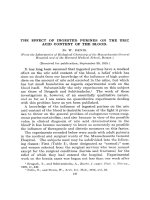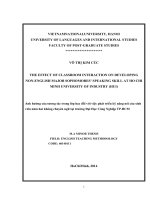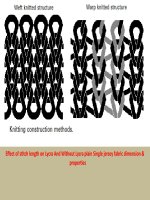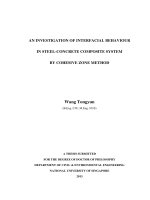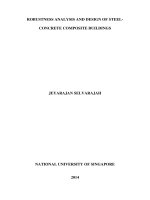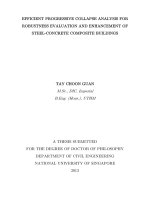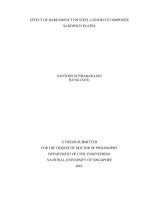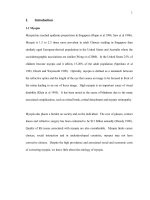Effect of hard impact on steel concrete composite sandwich plates
Bạn đang xem bản rút gọn của tài liệu. Xem và tải ngay bản đầy đủ của tài liệu tại đây (1.77 MB, 215 trang )
EFFECT OF HARD IMPACT ON STEEL-CONCRETE COMPOSITE
SANDWICH PLATES
SANTOSH SUNDARARAJAN
B.ENG (NUS)
A THESIS SUBMITTED
FOR THE DEGREE OF DOCTOR OF PHILOSOPHY
DEPARTMENT OF CIVIL ENGINEERING
NATIONAL UNIVERSITY OF SINGAPORE
2003
Acknowledgements
My sincere gratitude goes to my supervisor, Associate Professor W. A. M. Alwis, whose
contribution goes way beyond technical guidance. His emphasis on the fundamentals of
research, his undying spirit towards the exploration of the truth, in all fields and his
obsession with perfection were the sources of my motivation in the last few years. I am
also extremely grateful to my co supervisor, Professor P. Paramasivam who has always
expressed his confidence in me and offered advice and guidance when I needed it the
most. It was an extreme honour to work with such learned men and a pleasure to have
shared many a friendly conversations with both of them. My gratitude to Professor
Mohammed Maalej who took over the supervision from Professor Alwis in the final stages
of this work.
This work would have been impossible if not for the Laboratory staff who have been
extremely tolerant and helpful throughout my stint at the university. I sincerely thank
Edgar, Sit, Kamsan, Mr. Kho, Mr. Ang, Mr. Choo, Ishak and Annie each of whom has
made a tremendous contribution towards guiding me whenever I have been in trouble.
I thank mom dad and Chang for the love appreciation and motivation I constantly
received from them in spite of the physical distance that separated us during this period.
My special thanks to my fiancé Shilpa who has been my latest source of inspiration.
I dedicate this thesis to my grandfathers, both of whom in their own way emphasized
that education be perceived as an expense that enhances the quality of life rather than an
investment that will reap material benefits.
I thank one and all who in some way have contributed towards this thesis.
i
Table of Contents
Page
Acknowledgement i
Table of Contents ii
Summary v
Nomenclature vi
List of Tables vii
List of Figures viii
List of Appendix xi
Chapter 1: Introduction
1.1 General 1
1.2 Objective of Research 3
1.3 Scope of Research 5
1.4 Organization of Thesis 5
Chapter 2: Literature Survey
2.1 Introduction 7
2.2 Dynamic Loading 7
2.2.1 Impact Testing Techniques 9
2.2.2 Fracture Mechanics Approach 13
2.2.3 Penetration Tests 14
2.2.4 Plastic Shear or Punching Shear Failure 15
2.3 Behavior of Cementitious Composites Under Impact 20
2.4 Behavior of Metals Under Impact 23
Chapter 3: Experimental Investigation
3.1 Introduction 26
3.2 Materials 27
3.3 Material Strengths 27
3.4 Final Material Selection 27
ii
3.5 Test Setup 29
3.5.1 Test Procedure 30
3.6 Test Specimens 31
3.7 Conclusions 32
Chapter 4: Results and Discussions
4.1 Introduction 41
4.2 Specimen Integrity 41
4.3 Peak Strain and Plastic Recovery 43
4.3.1 Single Steel Plates 44
4.3.2 Double Steel Plates 46
4.3.3 Composite Sandwich Plates 46
4.3.4 Hoop and Central Strains 48
4.4 Time to Peak Strain and Strain Rate 50
4.5 Denting in Steel Plates 51
4.5.1 Single Steel Plates 51
4.5.2 Double Steel Plates 52
4.5.3 Composite Plates 52
4.6 Relation between dent depths and strain values 53
4.7 Strain rates of composite specimens 54
4.8 Conclusions 55
Chapter 5: Analytical Modeling of Impact Response
5.1 Introduction 78
5.2 Model Geometry 78
5.3 Material Model 79
5.4 Model Development 80
5.4.1 Stage 1: Preliminary Investigation 81
5.4.2 Stage 2: Model refinement 87
5.5 Conclusions 90
iii
Chapter 6: Results of the Analytical Modeling
6.1 Introduction 103
6.2 Analytical Model 103
6.3 Central Strains 104
6.4 Hoop Strains 112
6.5 Thin plates 113
6.6 Deflections and Dent Profiles 116
6.7 Stress Time Behavior 119
6.8 Reaction Force at the Support 126
6.9 Composite Plates 126
6.10 Conclusions 129
Chapter 7: Conclusions
7.1 Review of Present Study 149
7.2 Conclusions 150
7.3 Recommendations for Further Work 154
References 156
Publications 163
Appendix A (Aggregate Grading) 164
Appendix B (Strain Time Profiles) 166
Appendix C (Deflection Time Profiles) 185
Appendix D (Stress Time Profiles) 190
Appendix E (Reaction Force Response at Edge Supports) 195
Appendix F (Strain values for all tests ) 200
iv
SUMMARY
This dissertation presents experimental data pertaining to hard lateral impacts on plates.
An experimental program was conducted to study the behavior of steel-cementitious
composite sandwich plates under low velocity impact. Initiation of the punching mode of
failure was examined adopting a specially designed frame that minimized the bending of
the specimen. A 40 kg drop hammer, with a hemispherical head, under free fall from a
drop height of 4 meters, was used to create the impact. A set of 300mm x 300mm square
plates was used as test specimens and were subjected to lateral impact at their center. The
results showed large permanent deformations in the steel cover plates but no fracture.
Middle plates of normal and high strength concrete cracked into pieces under this kind of
impact. Introduction of a ferrocement or SIFCON layer to the middle plate reduced the
steel strains and also prevented disintegration of the middle plate. Use of a ferrocement or
SIFCON middle plate further reduced the steel strains and the dent depths. All the
specimens exhibited a typical strain time profile at the bottom surface of the bottom steel
plate. The strain increased to a peak value within the first millisecond after the impact and
then recovered partially to settle at a residual value within the next two milliseconds.
A FEM was calibrated based on experimental data. The material model for steel
was built to incorporate the strain rate effect. The model was then used to compute strains
and other parameters for steel plates when subjected to the impact conducted in the
experiments. Finite element modeling of steel plates helped to confirm some of the trends
observed in the experiments. Both the peak strain and the recovery from the peak strain
were seen to be a decreasing functions of the plate thickness.
v
NOMENCLATURE
t steel plate thickness (millimeters))
c
time to peak for central strains (milliseconds)
d depth of dent on steel plate (millimeters)
E Young’s elastic modulus of steel
Y
s
Yield stress of steel
p
Peak strain
r
Residual strain
c
Strain rate
pt
Peak tensile stress during impact
f
r
Peak reaction force
vi
List of Tables
Table 3.1: List of materials
Table 3.2: Material Strengths
Table 3.3: Mix proportions for chosen materials in Kg/m
3
Table 3.4: List of tests
Table 4.1: Middle plate integrity after impact
Table 4.2: Peak Strains and Recovery
Table 4.3: Central and Hoop Strains
Table 4.4: Dent Depths on Top and Bottom Steel Plates
Table 4.5: Time to peak(milliseconds)
Table 5.1: Effect of mesh size on computation of peak strain and recovery
Table 5.2: Effect of Young’s modulus on computations of the peak strain and recovery
Table 5.3: Effect of Yield Stress on computation of peak strain and recovery
Table 5.4a : Effect of Boundary Conditions on computation of peak strain and recovery
Table 5.4b: Effect of Extended Modeling on computations of peak strain and recovery
Table 5.5: Strain rate effect on computation of peak strain and recovery
Table 6.1: Peak Strain, Experimental and Computed values
Table 6.2: Recovery; Experimental and Computed Values
Table 6.3: Experimental and Computed values for Double Steel Plates
Table 6.4: Computed values for Peak, Residual and Recovery for Single Steel Plates
Table 6.5: Time to peak strain
Table 6.6: Hoop strains
Table 6.7: Deflections, Computed and Experimental
Table 6.8: Peak and residual stress values
Table 6.9: Equivalent steel plate thickness for composite middle plates
Table 6.10: Regression results (Peak strain against thickness)
Table 6.11: Regression results (Residual strain against thickness)
Table 6.12: Regression results (Dent depth against thickness)
Table 6.13: Regression results (Peak stress against thickness)
vii
List of Figures
Figure 3.1:Test Frame
Figure 3.2: Test Setup
Figure 3.3: Test Rig.
Figure 3.4: Drop Hammer
Figure 3.5: Impact Head
Figure 3.6a: Strain gauges on the steel plate
Figure 3.6b: Dent depth on steel plate
Figure3.7: Test specimens
Figure 4.1a: 5 mm Steel Plate after Impact
Figure 4.1b: 10 mm Steel Plate after Impact
Figure 4.2a: Normal Concrete Middle Plate after Impact
Figure 4.2b: Detail of central area of NC middle plate shown in Fig 4.2a
Figure 4.3a: Fragments of High Strength Concrete Middle Plate after impact
Figure 4.3b: Detail of the central portion of HSC middle plate shown in Fig 4.3a
Figure 4.4a: FRC Middle Plate (Macrofibres) after Impact
Figure 4.4b: Detail of the central portion of FRC (microfibres) Middle Plate after impact
Figure 4.5: SIFCON plus HSC composite Middle Plate after Impact
Figure 4.6: Ferrocement Middle Plate after Impact
Figure 4.7a: Typical Strain Time Profile
Figure 4.7b: Strain Time Profiles for Specimens SNC, SFRC1 and SSIFER
Figure 4.8a: Peak and Residual Central Strains for Single Steel Plates
Figure 4.8b: Peak and Residual Hoop Strains for Single Steel Plates
Figure 4.9a: Plastic Strain Recovery in Single Steel Plates
Figure 4.9b: Recovery as Percentage of Peak Strains for Single Steel Plates
Figure 4.10a: Peak and Residual Central Strains for Composite Specimens
Figure 4.10b: Peak and Residual Hoop Strains for Composite Specimens
Figure 4.11a: Plastic Recovery for Composite Specimens
Figure 4.11b: Recovery as a Percentage of Peak Strain for Composite Plates
Figure 4.12a: Hoop v/s Central Peak Strains for Single Steel Plates
Figure 4.12b: Hoop v/s Central Residual Strains for Single Steel Plates
viii
Figure 4.13a: Hoop v/s Central Peak Strains for Composite Plates
Figure 4.13b: Hoop v/s Central Residual Strains for Composite Plates
Figure 4.14a: Dent Profiles for Single Steel Plates
Figure 4.14b: Dent Profile for Composite Plates (Top Steel Plate)
Figure 4.15a: Dent Depth v/s Steel Plate Thickness (Single Steel Plates)
Figure 4.15b: Log of Dent Depth v/s Steel Plate Thickness
Figure 4.16: Dent Depths for Top and Bottom Steel plates (Composite Plates)
Figure 4.17: Time to peak for central and hoop strains
Figure 4.18: Regression results for Time to Peak strains (Central strains)
Figure 4.19: Normalized strain rates for composite specimens.
Figure 5.1: Modeling with solid and axisymmetric elements
Figure 5.2: Element mesh of plate (Plan View).
Figure5.3: Hammer and Plate as modeled.
Figure 5.4: Idealized stress strain curve for steel used in stage 1 of the model development
Figure 5.5: A 10 mm plate modeled with different mesh sizes.
Figure 5.6: Different boundary conditions investigated
Figure 5.7: Extended boundary conditions investigated.
Figure 5.8: Stress strain curve for mild steel used in experiments obtained from a lab test.
Figure 5.9: Idealized stress strain curve for steel used in the modeling.
Figure 6.1: Strain time response (20 mm steel plate)
Figure 6.2: Introduced change in plastic and elastic modulus of steel in the computations
due to an assumed increase in strength at higher strain rates
Figure 6.3a: Improvement in accuracy of computations of recovery as thickness increases.
Figure 6.3b: Recovery trend when expressed as a percentage of the peak strain.
Figure 6.4a: Peak Central strains
Figure 6.4b: Residual Central strains
Figure 6.5: Regressed straight line for Ln of strains (Peak and Residual)
Figure 6.6: Hoop strains
Figure 6.7: Deflection time profile for a 10 mm plate.
Figure 6.8: Residual Deflections
Figure 6.9: Recovery in strains and deflections
Figure 6.10: Dent profiles
ix
Figure 6.11: Stress time response (10 mm plate)
Figure 6.12: Probable stress strain curve during the impact.
Figure 6.13: Assumed stress-strain curve with unloading path
Figure 6.14: Derivation of the stress time profile from the strain time profile and the stress
strain curve
Figure 6.15a: Derived and simulated stress time profile (10 mm plate)
Figure 6.15b: Derived and simulated stress time profile (15 mm plate)
Figure 6.15c: Derived and simulated stress time profile (20 mm plate)
Figure 6.15d: Derived and simulated stress time profile (25 mm plate)
Figure 6.16: Peak and Residual Stress plotted against plate thickness (FEM)
Figure 6.17: Reaction Force against steel plate thickness
Figure 6.18: Chart of equivalent steel plate thickness for sandwich plates
x
List of Appendix
Appendix A: Aggregate Grading
Appendix B Strain Time Profiles
Appendix C Deflection Time Profiles
Appendix D Stress Time Profiles
Appendix E Reaction Force Response at Edge Supports
Appendix F Strain values for all tests
xi
Chapter 1 : Introduction
CHAPTER 1
Introduction
1.1 General
The resistance of a material to failure under load depends among many factors, on
the manner of application of the load. Three types of loading are normally recognized
based on the method of application; static loading (short term, slow and sustained),
repeated or fatigue loading, and impact loading. Impact loads are loads that are applied
suddenly or with shock normally leading to much higher strain rates than otherwise in the
impacted body. An important characteristic of impact is the generation of relatively large
stresses at the vicinity of contact for a very short period of time.
It has been well known for years that materials do not behave under dynamic
conditions as they do under static loading [1]. The behavior under impulsive loading is
complex and obscure and has not been extensively investigated. The study of material
behavior under such impact loading is of specific importance to structures that might be
subjected to blast or impact loading. Examples of these include defence shelters,
ammunition bunkers, firing ranges, tunnels, structure to shield mountain roads against
falling rock sheds, or marine structure shields meant for mitigating impacts caused by
ships. Structures where impact effects are important also include nuclear power plants,
containment structures for hazardous materials like chemicals, gas storage chambers, oil
platforms etc. Some examples of impact loading on concrete structures have been
compiled by Struck and Voggenreiter [2].
Dynamic loading by itself is still a diverse category. Blast loads, fragments that inflict
penetrative loading, hard impact that leads to elastic vibrations, impacts leading to
1
Chapter 1 : Introduction
permanent deformations all are different types of dynamic loading and each of them
results in a different material or structural response. Naturally such impact response would
depend on whether the material subjected to the impact remains within the elastic zone or
extends into the plastic or fracture zone. On the other hand, hard impact inflicted by an
object on a structure that is much larger than the impacting object is a specific subcategory
of dynamic loads that results in structural response quite different from other dynamic
loads like earthquakes because of its local effect. Such local impacts of a small object on
to a big structure are further divided into two types depending on the relative size and
velocity of the impacting object. A smaller object with higher velocities would normally
cause penetration in a ductile target. A relatively bigger object with a slower velocity
would lead to deformation that would normally extend into the plastic zone for a ductile
material, or fracture for a brittle material.
Design of structures to resist impact loading concentrates on two issues. One is to address
the structure as a whole. Studies in this direction concentrate on the structural vibrations
and frequencys response to try and minimize the possibility of a collapse under the
expected dynamic load. Another field of study concentrates on material behavior under
impact loads. Elastic materials like steel are known to have a high fracture toughness and
therefore high levels of resistance against impact loads. Brittle materials like concrete
offer very little resistance to impact loads, yet inclusion of randomly oriented discrete
discontinuous fibres improves many of its engineering properties, especially against
impact or abrasive loading. The concept of using fibres for such purposes is an old one and
has been reported to be in existence for 3500 years [3]. Use of natural fibres, namely coir,
cellulose, sisal, jute, etc. for structural purposes in concrete have been studied extensively.
However due to concerns of their durability, most recent research has concentrated on
2
Chapter 1 : Introduction
metallic and polymer fibres. An overview of fibre reinforced cement concrete technology,
mechanics of behavior, testing and performance, and applications in the past 30 years has
been documented by Zolo [4].
Fibres are grouped into two categories: low modulus of elasticity and high modulus of
elasticity. Synthetic fibres like nylon and other polymer based fibres belong to the first
category and steel, glass, carbon fibres fall in the second category. No significant increase
to compressive strength due to the use of any of these fibres has been reported. However
significant alterations of other properties like toughness and resistance to impact has been
recognized with the use of fibres within an otherwise brittle matrix of cement sand and
aggregates. Applications in which fibres are used primarily for the purpose of augmenting
the integrity of the matrix are much more common than applications where they are
required to act as significant load carrying components.
Often a layer of steel is used to protect a concrete structure from direct impact. This helps
in preventing chipping off of the concrete or fibre composite interior. Such measures are
adopted most commonly in blast doors, or in marine structures where the piers are likely to
be regularly subjected to impact by ships. However the resistance offered by the concrete
to the impact is still of importance. The steel only offers a protective layer to prevent
chipping. A scheme of sandwiching concrete between two steel plates is used extensively
for doors designed to resist blast loads. The steel is often used to take the bending load
inflicted during the impact.
1.2 Objective of research
This thesis addresses the issue of a hard impact at low velocities by a relatively large
object on sandwich plates made of two steel plates clamped to a cementitious composite
3
Chapter 1 : Introduction
core. The objective is to focus on the local denting effect of such an impact and eliminate
the bending effects. The performance of plates when various composites are used as the
middle plates in the sandwich system is studied. The effects of section geometry as well as
middle plate material composition are considered. Indentation of the solid steel plates is
adopted as a reference criterion for comparison of different cases. The expectation is that
such a study will assist in developing an understanding of indentation of blast doors or
similar structures possibly caused by accidental collisions with heavy objects, by
secondary fragments following an explosion, or by large shear forces generated under blast
loading at edges, hinges and locks [5]. The study would also prove useful for any
structural system when sandwich plates are used for protection against dynamic loading.
At a general level this study is expected to advance the understanding of material response
to dynamic loads and contribute to the literature which hopefully would lead to guidelines
for designing for dynamic loading.
The performance of plates when various composites are used as the middle plates
in the sandwich system is also studied based on the tests that has been designed. The
effects of section geometry as well as middle plate material composition are considered.
Indentation of the solid steel plates is adopted as a reference criterion for comparison of
different cases. The expectation is that such a study will assist in developing an
understanding of indentation of blast doors or similar structures possibly caused by
accidental collisions with heavy objects, by secondary fragments following an explosion,
or by large shear forces generated under blast loading at edges, hinges and locks [5]. The
study would also prove useful for any structural system when sandwich plates are used for
protection against dynamic loading. At a general level this study is expected to advance
the understanding of material response to dynamic loads and contribute to the literature by
4
Chapter 1 : Introduction
designing a testing method to quantitatively measure and compare performances of plates
under a punching impact. Eventually this would hopefully lead to guidelines for designing
for dynamic loading.
1.3 Scope of research
The scope of loading considered is that of a hard local punch by a rigid object on a plate.
The damage inflicted would deform the material well into the plastic zone leaving a
permanent deformation. Fracture, tearing and penetration however are not addressed. The
deformation is examined both analytically and experimentally in terms of strain time
response and permanent deformation as manifested by dents. The experimental work
involved impact caused by a drop hammer and studying of deformation response when
different cementitious materials are adopted for the middle plate. Analytical investigations
are conducted by a finite element analysis.
1.4 Organization of thesis
In Chapter 1, a general introduction is provided that zooms in to the specific area of
research addressed in this thesis, that of a particular subcategory of the general
phenomenon of impact. An introduction is also provided on the use of fibres to improve
toughness of brittle materials. Finally the objective of this research and the scope of study
are detailed.
Chapter 2 presents a detailed literature survey that summarizes past work done in relevant
fields in impact and material research.
5
Chapter 1 : Introduction
In Chapter 3, a material study conducted is briefly described. This study involved a set of
cementitious materials which were cast and tested in the laboratory. A limited collection
of materials were chosen for use as middle plates for impact testing. The apparatus and the
method of testing adopted along with the list of specimens tested are presented in detail.
In Chapter 4, the results of the experiments are discussed. Certain trends are identified
and comments are made on the plausible explanations for these trends. Certain anomalies
that could not be explained have also been identified.
In Chapter 5 the finite element analysis conducted for studying the impact problem
analytically is introduced. The steps taken to validate the model and arrive at a scheme that
best matches the experimental observations are described in detail.
Chapter 6 provides a comparison of the experimental observations and the analytical
simulation. Finally this chapter takes a look at the behavior of certain other parameters like
the stress in the steel cover plate as predicted by the computational analysis.
Chapter 7 concludes the main findings of the study and lists further work that
could be carried out to further advance the knowledge addressed in this thesis.
6
Chapter 2: Literature Survey
CHAPTER 2
Literature Survey
2.1 Introduction
This study focuses on hard impact on sandwich plates made of cementitious composites
sandwiched between steel plates. The resulting response is one that accompanies
reasonably high strain rates. The behavior of both steel cover plates and the cementitious
middle plates are studied. Steel stressed under such impacts would normally progress to
the plastic zone and no cracks will result. The cementitious middle plate, however, would
crack and normally the failure is brittle in nature. The literature surveyed accordingly
focuses on the plastic behavior of steel and the fracture of cementitious composites. The
type of impact is also very specific, that of a hard projectile inflicting a dent on a plate.
The literature presented here also covers a comprehensive survey of impact tests used and
reported so far. This chapter is therefore subdivided into three sections: impact tests,
response of cementitious composites, and response of steel.
2.2 Dynamic testing
Impact maybe classified as soft or hard based on the deformation characteristics of the
projectile used. When the projectile deformability is large compared to the target
deformability the impact is known as a soft impact, and if the projectile deformability is
relatively small it is known as a hard impact. Projectile deformation in a soft impact would
consume some energy and hence would result in diminished local damage of the target.
7
Chapter 2: Literature Survey
Impact can either be a low or high velocity impact based on the velocity of the projectile.
Projectile velocities less than 25 m/s may generally be considered as low velocity impact.
Along the same classifications of impact we have a penetrative and a non penetrative
impact. Typically penetration is directly related to both the velocity of the impact and the
properties of the target material. While a brittle material like concrete can be subjected to
penetrative impact even by a low velocity projectile, a ductile material like steel would not
be penetrated by such impacts.
There is at present no generally accepted method for evaluating the impact properties of
concrete structures for design, either from a material or structural point of view. The
equivalent static load approach is the most commonly accepted, as structural designers are
accustomed to this method. But it is recognized and accepted that due to different material
behavior at different strain rates, a rational design approach for impact loading is
desirable. Therefore in attempts to address the issues associated with impact loading of
materials, many studies have been undertaken. Different tests like the drop weight test,
Charpy test, swinging pendulum test, explosive test and split Hopkinson bar test have been
developed to study impacts and impulsive loads.
The early history of impact tests and some of the improvements in procedures that have
occurred over time are recounted in [6]. Over the years researchers have realized that the
results obtained from an impact test can depend strongly upon the size and geometry of the
specimen and the striker and to a lesser degree on the velocity and energy lost to the
testing machine and elsewhere. The earliest publication on impact loading reported is a
theoretical discussion by Tredgold in 1824 on the ability of cast iron to resist impulsive
forces [7]. In 1849 the British formed a commission to study the use of iron in the railroad
industry and began considering practical approaches of impact testing [8]. During this
8
Chapter 2: Literature Survey
study researchers speculated that impact loads affected material far differently than static
loads and therefore tensile strength data were a poor predictor of performance under
dynamic loads. In 1857 Rodman devised a drop-weight machine for characterization of
gun steels. However instrumentation was very poor in those days and the data were often
limited to observations of “break” or “no break” for a standard mass dropped from a fixed
height. Ductile materials often however, would only bend under such loads and would not
fracture. LeChatalier introduced the use of notched specimens while conducting drop
weight tests in 1892 [9]. A report by Russell, 1898, introduced for the first time some
quantitative measurements into the tests [10]. His report shows a test machine that is based
on the same swinging pendulum concept as those commonly in use today and mentions a
careful analysis of the mechanics of the test, including correction for friction losses and
calculation and comparisons of the centers of gravity and percussion. In 1905 Charpy had
proposed a machine design which is remarkably similar to present designs and the
literature contains the first reference to ‘the Charpy test’. However impact testing was not
a common requirement in construction standards until the recognition of its ability to
detect the ductile-to-brittle transition in steel. A large number of ship failures during the
World War 2 provided the single greatest impetus towards implementation of impact
testing in fabrication standards.
2.2.1 Impact testing techniques
The Charpy test is the most commonly used impact test and it measures the impact
resistance of metallic materials. The specimens are standard specimens each having an
accurately formed notch and the energy for the impact is obtained by releasing a pendulum
from a known height. The specimen is supported at the bottom of the arc described by the
9
Chapter 2: Literature Survey
pendulum, as a beam. When the pendulum is released it swings down, breaks the
specimen, and rises on the upswing. The height to which the pendulum rises indicates the
residual energy in the pendulum, from which the energy required to break the specimen
can be approximated. However when tested by this method, specimens of same material
and of similar geometric proportions, but different size, will not provide equal values of
modulus of toughness, which is normally defined as energy per unit area of fracture. Thus
this test only supplies an index of material toughness but no measure of the toughness as a
fundamental property of the material. The specimen is placed in such a way that the root of
the notch is tested in tension. The Izod test, another similar test, mounts the specimen as a
cantilever instead of a beam.
Pendulum impact tests such as the Charpy and Izod tests are standardized in many
countries. Although these testing methods were established about a hundred years ago,
their practical usefulness as simple methods for assessing mechanical properties of
material under impact has scarcely deteriorated mainly because the tests can be conducted
easily and it enables useful relative characterization of materials. Such relative
characterization is often sufficient to compare a newly developed material in performance
against existing materials. However with continuous demands for materials which exhibit
higher performance under impact loading, critical or absolute characterization of materials
has grown more and more important. A new technique was developed by Kishimoto,
Inoue and Shibuya for measuring the impact force in the instrumented Charpy impact test.
This technique makes it possible to estimate the impact force between the striking edge of
the tip and the specimen from the measured response of the hammer. This removes the
effect of the mechanical vibration of the hammer on the output of the sensor [11].
Fracture toughness is often estimated from Charpy fracture energy by empirical correlation
10
Chapter 2: Literature Survey
formulas, although the latter are known to be in general of poor accuracy and valid only
under restrictions. A mathematical relation between the fracture toughness and the Charpy
fracture energy has been proposed by Schindler [12].
The Charpy impact test, originally recommended for metals, has been employed to
evaluate impact performance in terms of energy absorption capacity of steel fibre
reinforced concrete relative to unreinforced matrix [13]. Tests by simple drop weights and
swinging pendulums are used to ascertain the relative merits of different composites, but
these tests do not yield basic material characteristics that can be used for design. However
many modifications to the original Charpy test have been innovated. Instrumented impact
testing gives a better understanding of the impact process and provides quantitative data
that may be helpful in design.
The Split Hopkinson bar test enables determination of stress-strain responses in
compression and tension at high strain rates. The test was developed by Kolsky in 1949
[14]. The specimen located between two long bars, namely the incident and transmitter
bars, is held in this way to generate either a tensile or compressive stress pulse through the
specimen. The stress pulse is generated at the free end of the incident bar by an impacting
bullet or an explosive charge. The high strain rate behavior of cement composites in
uniaxial tension was studied using the split Hopkinson bar test by Reinhardt et al [15].
Compressive behavior was also investigated using this apparatus [16].
The drop weight test involves the dropping of a weight on a specimen typically from
successively increasing heights till the specimen fails. The energy absorbed in the failure
process is taken as the weight multiplied by the height of the final drop. Such a procedure
disregards the probable weakening effect of blows received prior to final failure. ACI
Committee 544 proposed a repeated drop-weight testing apparatus for testing FRC
11
